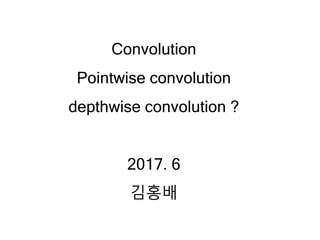Convolution 종류 설명
•Descargar como PPTX, PDF•
11 recomendaciones•10,366 vistas
홍
홍배 김Xception, MobileNets등에서 활용되는 pointwise(1x1)convolution, depthwise convolution에 대한 설명
Denunciar
Compartir
Denunciar
Compartir

Recomendados
Más contenido relacionado
La actualidad más candente
La actualidad más candente (20)
文献紹介:Temporal Convolutional Networks for Action Segmentation and Detection

文献紹介:Temporal Convolutional Networks for Action Segmentation and Detection
Destacado
Destacado (16)
InfoGAN: Interpretable Representation Learning by Information Maximizing Gene...

InfoGAN: Interpretable Representation Learning by Information Maximizing Gene...
Knowing when to look : Adaptive Attention via A Visual Sentinel for Image Cap...

Knowing when to look : Adaptive Attention via A Visual Sentinel for Image Cap...
Explanation on Tensorflow example -Deep mnist for expert

Explanation on Tensorflow example -Deep mnist for expert
Meta-Learning with Memory Augmented Neural Networks

Meta-Learning with Memory Augmented Neural Networks
Single Shot MultiBox Detector와 Recurrent Instance Segmentation

Single Shot MultiBox Detector와 Recurrent Instance Segmentation
Más de 홍배 김
Más de 홍배 김 (14)
Automatic Gain Tuning based on Gaussian Process Global Optimization (= Bayesi...

Automatic Gain Tuning based on Gaussian Process Global Optimization (= Bayesi...
Learning agile and dynamic motor skills for legged robots

Learning agile and dynamic motor skills for legged robots
Anomaly Detection and Localization Using GAN and One-Class Classifier

Anomaly Detection and Localization Using GAN and One-Class Classifier
ARCHITECTURAL CONDITIONING FOR DISENTANGLEMENT OF OBJECT IDENTITY AND POSTURE...

ARCHITECTURAL CONDITIONING FOR DISENTANGLEMENT OF OBJECT IDENTITY AND POSTURE...
Convolution 종류 설명
- 1. Convolution Pointwise convolution depthwise convolution ? 2017. 6 김홍배
- 2. 최근 Xception, MobileNtes등에서 사용되는 다양한 convolution 기술 중 일반적인 convolution, Pointwise convolution (1x1 convolution)과 depthwise convolution의 차이는 ? 목적 : CNN의 계산량 및 매개변수 수를 줄임으로써 Xception은 큰 이미지 인식의 고속화 MobileNets은 정도를 유지하면서 Networks의 경량화
- 3. Pointwise convolution과 depthwise convolution의 장점을 이해하기 위해, 우선 일반 convolution의 계산량 및 parameter 수에 대해 생각해보면 어떤 CNN에 대한 입력 특징 맵의 크기를 FxF, 입력 채널 수를 N, 커널 크기를 KxK, 출력 채널 수를 M으로 하면, 이 CNN의 계산량은 F2NK2M이 된다.
- 4. 이것은 입력 특징 맵 1개당 Convolution의 cost가 K2N으로 이를 입력 특징 맵 F2 개에 적용해서 1 채널의 출력 특성 맵이 생성되기 때문에, 출력 특징 맵이 M개 경우에는 위의 계산과 같다. parameter 수가 K2N의 Convolution이 M종류이기 때문에, K2NM이 된다.
- 5. Pointwise convolution Pointwise convolution은 ResNet등의 skip connection에도 이용되는 1x1 convolution이다. 공간 방향의 convolution은 실시하지 않고, 채널 방향에만 convolution을 한다. 특징 맵의 차원을 늘리거나 줄일 때 이용된다. Pointwise convolution은 일반 convolution에서 K = 1로 한 것이기 때문에, 계산량은 F2NM, parameter 수는 NM이 된다.
- 6. Depthwise convolution Depthwise convolution는 특징맵 채널마다 각각 공간 방향의 convolution 을 수행한다. 채널 방향에 convolution을 수행하지 않기 때문에 일반 convolution 1회의 cost가 K2N에서 K2로 되므로 CNN의 계산량은 F2NK2, parameter 수는 K2N이 된다.
- 7. 일반적인 convolution이 특징 맵의 공간 방향 및 채널 방향으로 동시에 convolution 을 실 시 하 는 반 면 , 채 널 방 향 의 convolution(pointwise convolution)과 공간 방향의 convolution (depthwise convolution)을 분리 (factorize)해서 따로 계산한 후 후에 합쳐서 적용하여 공간 방향 및 채널 방 향을 동시에 convolution하는 convolution보다 적은 parameter 및 계산량으 로 근사 할 수있다. 계산량은 F2NK2M에서 F2NM + F2NK2로 감소된다. 비율로 말하면, 1/K2 + 1/M으로 되므로, 통상 M >> K2(e.g. K = 3, M≥32)이므 로, 계산량은 1/9 정도로 감소됨